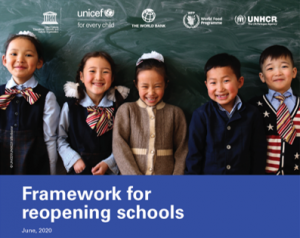Global Framework for Education Statistics Post-COVID-19

The COVID-19 crisis has affected the education sector hard. The closing of schools has interrupted the normal function of the system, reducing student learning, and restricting the amount of administrative and student assessment data available to education authorities, parents, and decision makers. However, as the crisis wanes, many important decisions need to be made now to anticipate the reopening of schools and the restoration of normality in the education system and in the life of students and their families.
The medium and long-term effects of the COVID-19 pandemic are still uncertain, but the need to continue educating children, and the need to restore the learning losses brought in by the crisis, requires short-term actions by Ministry of Education and other Government authorities. To that end, there is an urgent need for essential information at the school level that can be used to guide decisions on policies, financial support, the assignment of personnel, and the implementation of educational platforms for delivering education in person and remotely.
UNESCO, the World Bank Group (WBG) and UNICEF have launched the Framework for Reopening Schools, a flexible tool for policy makers and planners highlighting all the factors that will make this experience a successful one for students, teachers, principals, parents and the wider community.
Objective
Build a preliminary statistical framework for COVID-19 and provide a checklist of good practices. The Framework will guide the data collection and indicators framework which will allow governments in low- and middle-income countries to have a clearer picture of the situation, and help them identify specific issues related to the reopening of schools under critical conditions.
A statistical framework
This statistical framework pertains strictly to measurement only, and tries to identity the data requested to follow up on impact and as well as identify opportunities to utilize existing data sources. Further, the availability of data will also be impacted by the COVID-19 crisis while new sources of the information will have to considered.
Structural indicators to assess
A set of indicators to assess the impact of COVID-19 on the functioning of the education sector, acknowledging that the pandemic will have effects on several aspects of the economic and social lives of individuals (examples of those possible impacts are included in the annex of this note) is proposed. Some of these indicators are currently produced and disseminated by the UNESCO Institute for Statistics.
Suggested indicators to monitor the impact of the COVID-19 pandemic
- Number of children (and % of children in the relevant age-group) in the program area supported with distance/homebased learning/tutoring programs
- Proportion of enrolled students who were asked to stay home (measured at national, regional and global level). Measures the immediate short-term impact of school closures.
- Proportion of students in each country that benefitted from online learning resources during school shutdown due to the COVID-19 crisis. This will allow to assess the capacity of education systems to provide distance education and necessary investment to improve that capacity.)
- Number (and %) of children who return to school once the school system is reopened
- Number of radio stations/TV programs/ online platforms broadcasting emergency distance learning programs.
- Number of children (and % of children across the 67 countries) provided access to programs and sensitization campaigns that aim at minimizing the negative impacts of school closure like psychological impacts, gender-based violence, and issues related to unequal social norms.
- Students not receiving meals through school feeding programmes (monitored by World Food Programme)
- Number of teachers trained in using distance learning methods and/or provided materials to support distance learning
- After school reopening: number of teachers trained to provide accelerated programs to mitigate loss of learning during school closure
- Number (and % of children) of children whose learning was assessed to evaluate loss of learning during school closure
- Percentage of children assessed during school closure who meet relevant minimum learning standards
- Number of countries, where parents and caregivers reached through mechanisms to inform parents and community leaders of distance learning content and teaching methods
- Gender equality:
Number of girls, youth groups and community groups including women’s rights organizations reached and supported to strengthen education response efforts
UNESCO. (2019). Retrieved from: https://learningportal.iiep.unesco.org/en/glossary/educational-management-information-system-emis. Accessed November 2019.